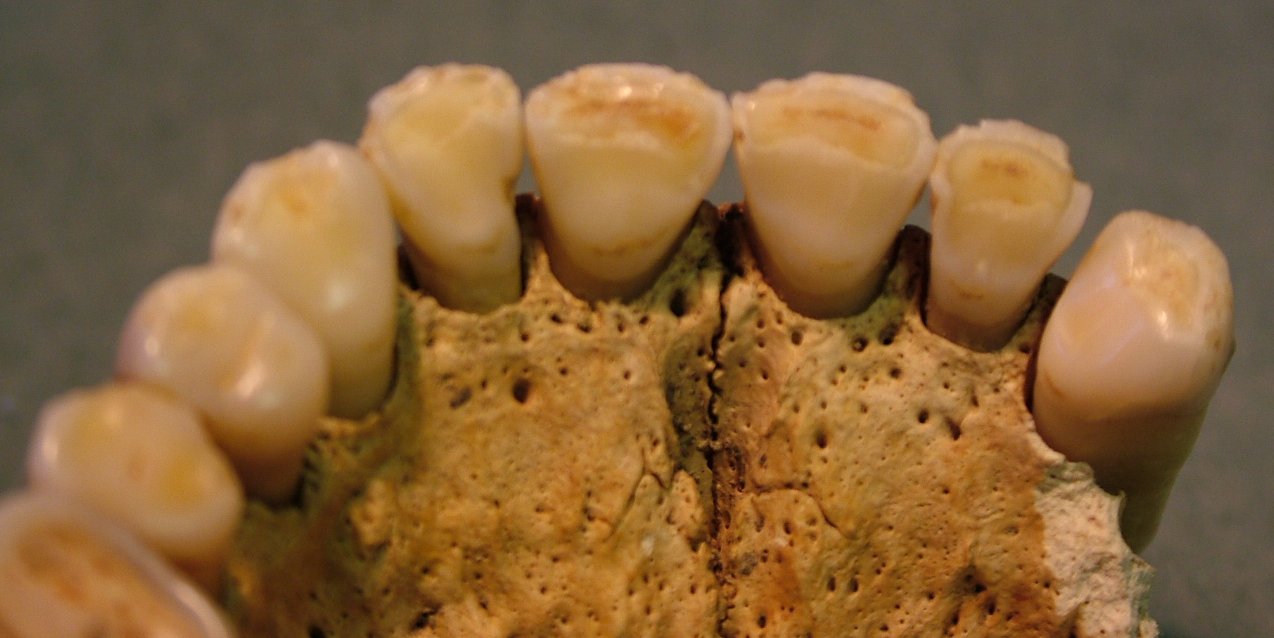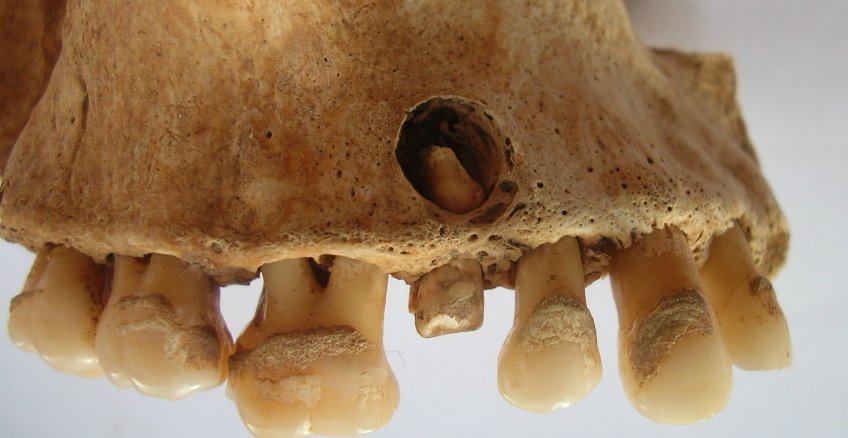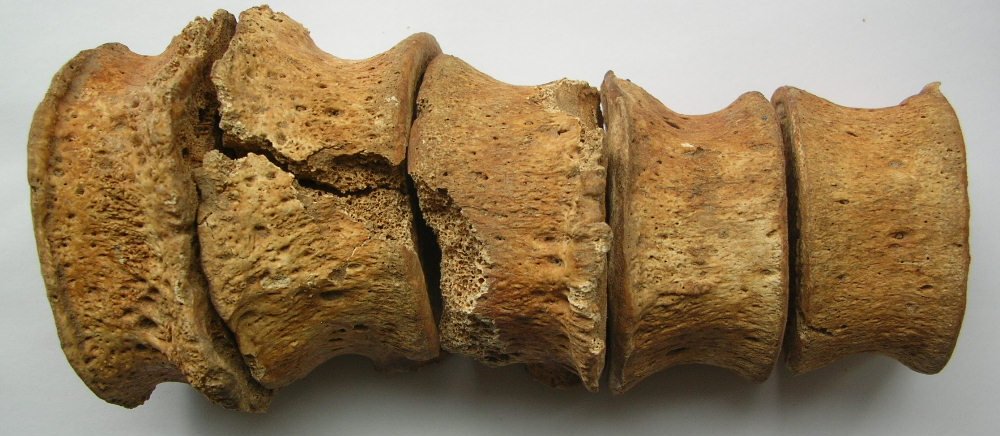Bronze Age Roundhouse in Clare – Pt 2 – The Burials
This is the second part of a three part post on excavations carried out at Barnhill, Co. Clare. The first part is here and consists of details of a Bronze Age Round house which was excavated. The third part will comprises a bibliography for further reading and is located here. This part (II) is derived from a detailed osteological report prepared by Sarah Porteus for Moore Group.
Eighteen inhumations of varying orientations were also excavated across the site. These burials post dated the ditch feature. The twelve adult and six juvenile skeletons recovered from Barnhill Woods appear to be representative of a rural population, with periods of malnutrition suffered by all ages. The individuals were most probably eating a coarse diet without refined sugars. Chipping to the anterior teeth of two adult males is suggestive of the use of teeth as a tool during life. The occupation of these individuals may have involved gripping iron nails, or other hard objects, between the teeth such as carpentry or cobblers nails. Most individuals had undertaken physical work resulting in degeneration of the spine over time. Burial position was mostly supine extended with hands placed across the pelvis, though burial orientation was variable. Two grave cuts contained multiple burials, with the rest being simple individual burials. No infant remains were recovered, which may indicate their exclusion from the burial ground. As no definitive date is known for the individuals pending the results of C14 dating the burials are thought to date from between a wide period from AD500 and AD1800.

Multiple chipping to the maxillary incisors and canines of SK21
The individuals from Barnhill Woods appear to have led lives which were prone to sporadic periods of illness or malnutrition in childhood resulting in periods of arrested growth, indicated by the presence of linear enamel hypoplasia in the teeth. The presence of active and healed porotic hyperostosis and cribra orbitalia in the adult population suggest that the pattern of illness and malnutrition continued into adulthood. In a rural community seasonal availability of certain foods may have sufficient effect upon the individual to result in periods of arrested growth. Sporadic episodes of serious illness may have had an impact on the absorbtion of nutrients by the body of some of the individuals when fighting a disease. As many of the cases of porotic hyperostosis had begun to heal most of the individuals were recovering from these episodes of malnutrition or illness. Overall, living conditions for the individuals appears to have been harsh with periods of disease and malnutrition.
Cont’d under the fold……


Apicial abscess of the 2nd right maxillary premolar of SK2
The teeth from the sample give clues to the diet and possible occupation of the individuals. It is likely the diet consisted of starchy foods without refined sugars, as indicated by the location of the carious lesions in the teeth. The presence of calculus build up on the teeth and resulting periodontal disease indicates that little attention was paid to oral hygiene. Tooth chipping occurred in the dentition of three individuals from the Barnhill Woods sample. One young adult female had chipping to the surfaces of molar teeth 25 and 28. The wear to the molar teeth is more likely attributable to coarse grit in the diet, a possible result of the grain milling process. Two adult males had chipping to the anterior teeth, this was more marked on the maxillary incisors than the mandibular teeth of one. This pattern is unlikely to represent coarse elements in the diet as this would likely affect the masticatory teeth; the molars. Damage to the incisor teeth could be caused by gripping hard objects in the front teeth. Occupational abrasion to teeth has been observed in archaeological populations (Irish and Turner, 1987; Luckacs and Pastor, 1988; Turner and Anderson, 2003) and most commonly occurs in the anterior teeth. Cobblers, carpenters and dressmakers are most commonly cited as having notches on ‘the incisal edges of the anteriorly placed teeth’ (Karmakar, 2005:143). All these occupations would have been active in Co Clare during the period in which the Barnhill Woods individuals were alive and it is possible some of these individuals may have been engaged in such activities. The chips are too irregular to identify possible tools which would have been held between the teeth and a single occupation cannot be identified. It is possible accidental damage through knocks or falls, food processing or holding everyday objects in the teeth may also have resulted in the damage seen to the teeth.

DJD of the lumbar spine of SK21
‘Joint disease is the most frequent type of post-cranial pathology to be found in both skeletal material and modern populations’ (Rogers 2000, 163). Joint disease includes, amongst others, osteoarthritis, rheumatoid arthritis, and ankylosing spondylitis. Where new bone growth and porosity are visible at joint surfaces and cannot be attributed to one of the above disorders a diagnosis of ‘degenerative joint disease’ (DJD) is given. Most of the individuals at Barnhill had been involved in heavy lifting and other stresses to the back. These individuals daily lives most likely consisted of a degree of physical labour resulting in degeneration of the spinal joints over time.
Young adults are generally more resistant to the effects of disease than any other age group. The lack of older individuals on site and only one middle aged adult, with all but one individual dying in young adulthood or earlier, supports the theory that life was hard for the individuals represented in the cemetery.
The presence of grave cuts containing multiple burials in a cemetery with a low density of burials is of some interest. No possible cause of death was apparent for any of the individuals buried within these graves. The juveniles buried together were both of approximately the same age in late childhood, with the other multiple grave being of two adults. The reasons for the multiple burials can only be suggested. The individuals may have been related and/or had died within a short time of each other and were buried together. It is possible the individuals were buried together to save time and effort of excavating multiple grave cuts. Numerous outcrops of rock in the area may have made excavation of multiple regularly spaced graves difficult and it may have been easier to bury individuals together in the one grave where a suitable spot was found. The author has found preservation of buried infants to be better than that of adults and infants are usually identified on site where present. The lack of infant remains on the site may hint at burial practice being different for the very young. As the burial ground was not fully excavated it is possible that very young individuals were buried in parts of the burial ground not excavated. If the burial ground dates from the Christian period the lack of infants in the burial ground may reflect the practice of not burying the un-baptised on holy ground. It is also possible that infant remains may not have been recovered from the site on account of their burials having been shallower and eroded away over time.
Though no statistically significant results can be drawn from the small sample at Barnhill Woods, the skeletal evidence from Barnhill woods is consistent with what would be expected from a rural population from Ireland from the Medieval or early Christian period.
This entry was posted on Thursday, February 12th, 2009 at 11:58 am. It is filed under About Archaeology, Papers & Reports and tagged with archaeological consultants galway, Barnhill, Clare, Dromoland, Moore Group, osteology, Sarah Porteus.
You can follow any responses to this entry through the RSS 2.0 feed.






I much prefer inorfmtiave articles like this to that high brow literature.